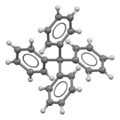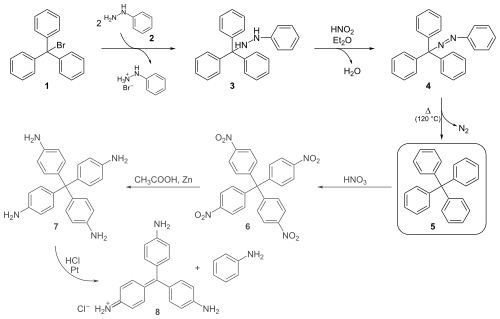| Revision as of 09:56, 26 November 2023 editMeodipt (talk | contribs)Autopatrolled, Extended confirmed users, Pending changes reviewers, Rollbackers35,723 edits →See also← Previous edit | Revision as of 01:58, 25 December 2023 edit undo1234qwer1234qwer4 (talk | contribs)Extended confirmed users, Page movers198,169 edits added Category:Substances discovered in the 19th century using HotCatNext edit → | ||
| Line 79: | Line 79: | ||
| ] | ] | ||
| ] | ] | ||
| ] | |||
Revision as of 01:58, 25 December 2023
| |||
| Names | |||
|---|---|---|---|
| Preferred IUPAC name 1,1′,1′′,1′′′-Methanetetrayltetrabenzene | |||
| Identifiers | |||
| CAS Number | |||
| 3D model (JSmol) | |||
| ChemSpider | |||
| ECHA InfoCard | 100.010.132 | ||
| EC Number |
| ||
| PubChem CID | |||
| UNII | |||
| CompTox Dashboard (EPA) | |||
InChI
| |||
SMILES
| |||
| Properties | |||
| Chemical formula | C25H20 | ||
| Molar mass | 320.44 g/mol | ||
| Melting point | 282 °C (540 °F; 555 K) | ||
| Boiling point | 431 °C | ||
| Structure | |||
| Crystal structure | tetragonal | ||
| Space group | P421c, No. 114 | ||
| Point group | S4 | ||
| Lattice constant | a = 10.896 Å, c = 7.280 Å(20 °C) | ||
| Formula units (Z) | 2 | ||
| Hazards | |||
| GHS labelling: | |||
| Pictograms | 
| ||
| Signal word | Danger | ||
| Hazard statements | H350 | ||
| Precautionary statements | P201, P202, P281, P308+P313, P405, P501 | ||
| Except where otherwise noted, data are given for materials in their standard state (at 25 °C , 100 kPa).
| |||
Tetraphenylmethane is an organic compound consisting of a methane core with four phenyl substituents. It was first synthesized by Moses Gomberg in 1898.
Synthesis
Gomberg's classical organic synthesis shown below starts by reacting triphenylmethyl bromide 1 with phenylhydrazine 2 to the hydrazine 3. Oxidation with nitrous acid then produces the azo compound 4 from which on heating above the melting point, nitrogen gas evolves with formation of tetraphenylmethane 5.
Gomberg was able to distinguish this compound from triphenylmethane (elemental analysis was not an option given the small differences in the hydrogen fractions of 6.29% and 6.60%) by nitration of 5 with nitric acid to 6. A strong base would be able to abstract the methine proton of the nitrated triphenylmethyl compound if present, forming a strongly colored compound.
He obtained further evidence for the formation of tetraphenylmethane by reducing the nitro groups to amino groups with zinc dust in acetic acid to the leuco dye 7, which on exposure to hydrochloric acid eliminates aniline to the known compound pararosaniline 8.
Gomberg's success in synthesizing tetraphenylmethane set him on the attempt to prepare the next homologue hexaphenylethane, which led him to the discovery of the triphenylmethyl radical.
See also
References
- Robbins, A.; Jeffrey, G. A.; Chesick, J. P.; Donohue, J.; Cotton, F. A.; Frenz, B. A.; Murillo, C. A. (1975-10-01). "A refinement of the crystal structure of tetraphenylmethane: three independent redeterminations". Acta Crystallographica Section B: Structural Crystallography and Crystal Chemistry. 31 (10): 2395–2399. doi:10.1107/S0567740875007686. ISSN 0567-7408.
- Gomberg, M. (1898). "On tetraphenylmethane". J. Am. Chem. Soc. 20 (10): 773–780. doi:10.1021/ja02072a009.


